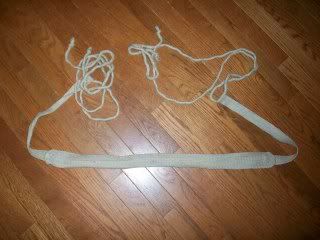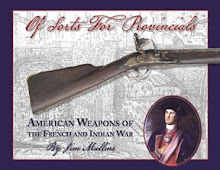One of the most difficult items from the Hastens/Hastings inventory ( http://www.danielhaston.com/people/david-hastings-died1776.htm ) to document and replicate has been his "Hoppis" (evidently the Delaware word for a tumpline, a kind of burden strap).
ca. 1736 shows a tumpline in use in Georgia
John Heckewelder (1788)
"It is very common to see a hunter come in with a whole deer on his back, fastened with a hoppis, a kind of band with which they carry heavy loads. It rests against the breast, that which the women rest against the forehead."
from David Zeisberger's History of North American Indians:
"...who carry everything by means of a carrying girth fixed to the forehead, whence the whole burden and (a hundred weight is not considered heavy) is suspended down the back. The men carry everything hung to a carrying girth fixed across the chest. A deer weighing from a hundred to a hundred and thirty pounds they will carry the entire way home before allowing themselves to rest. These carrying girths are made of wild hemp which is first spun. That part of these girths which passes across the breast and over the shoulders is three fingers broad and decorated with various figures. From it depend long plaited, durable bands, to which the burden is bound."
rear view of a utilitarian Iroquois "Warrior tie or burden strap, tumpline made of hemp."
50 cm long ca. 1710 British Museum Sir Hans Sloane collection
50 cm long ca. 1710 British Museum Sir Hans Sloane collection
One of my favorite images from the 18th century that depicts a tumpline and encampment is the 1764 "Bouquet" Map by Hutchins (see lower left under the tree with guns leaning against it):
For further info on the Native end of things (and links to some original tumplines), I recommend checking out these links:
https://frenchinwisconsin.com/2013/09/21/the-humble-tumpline/
http://amohkali.southeasterntrading.com/tumplines.htm
http://www.nativetech.org/finger/belts.html
Native style burden straps or tumplines were sometimes adopted and used by Anglo soldiers and militiamen in the 18th century, but this practice seems to have been more common North of our focal point of Virginia.
Gary S. Zaboly's article "The Use of Tumplines in the French and Indian Wars" (Military Collector Historian &, vol. XLVI, No.3 Summer 1994, pp. 109-113) covers this aspect nicely and has quite a few great references in it. Besides the Hastens/Hastings inventory, a few other references can be found in the south, this one specific to the Cherokee campaign of 1761:
"They threw away those articles which hung by Tomplines over thier Shoulders & some of them even cast off their Bayonets as soon as the Indians began to Fire upon the Line "
The Papers of Henry Laurens: January 1, 1759-August 31, 1763 2nd March 1763 A LETTER SIGNED PHILOLETHES
$30 1777 South Carolina note
motto surrounding inset reads: "Misera servitus omnis" (All slavery is wretched).
Having established what this particular piece of equipment was, the next challenge was interpreting how Hastens/Hastings (or whoever) manufactured it. As far as I know, there are no extant tumplines with a Virginia military or militia provenance. Native manufactured tumplines seem to have been generally woven of local plant fibers (basswood, Indian hemp and etc) but the few scattered references I can find from Virginia and other colonial sources seemed to point towards hemp or leather.
Although far north of Virginia, Captain John Knox's Journal (1759 page 352 V1) mentions that British soldiers using webbing during the French and Indian War:
"His knapsack is carried very high between his shoulders, and is fastened with a strap of web over his shoulder, as the Indians carry their pack."
This practice continued to be used to some extent in the British army during the Revolutionary war (thanks to Jay Callaham for sharing this info on the RevWar Progressive list), although sometimes the term "blanket sling" was used:
"Brigade (of Guards) Orders 11 March 1777
"The Waistbelts to Carry the Bayonet & to be wore across the Shoulder. The Captains are desired to provide Webbing for Carrying the Mens Blankets according to a pattern to be Seen at the Cantonment of Lt. Colo. Sr. J. Wrottesleys Company. The Serjeants to Observe how they are Sewed. The Officers to Mount Guard with their Fuzees."
(1st Guards Orderly Book)"
1st Battn (Brigade of Guards) Orders 9 September 1779
"The Men lately Joind having received their Field Blankets, the Serjts. are Ordered, to see that they are Mark'd with the Initial Letters of each Mans Name. The Men are to be provided with proper Straps for Carrying them & Shewn how to Roll them up."
Some of these blanket slings were being made of "Diaper webbing"
THE ROYAL GAZETTE. 04/04/1778 "Sharwin, Sadler at the coffee House Bridge, has imported from London...Diaper web for officers tents, chair bottoms, and blanket slings for soldiers"
In addition, some British units were using tumplines or blanket slings in conjunction with wallets:
From the 40th Regiment Order Book [as per James Kochan's transcription]:
"......They are to parade with their Necessarys and blanketts neatly packd.
up" [egimental]:O[rders] 14th May 1777
"Each Compy. will immediately receive from the Qr. Mr. Serjt. 26 Slings & Wallets to put the quantity of Necesareys Intendd. to be Carrid. to the field Viz 2 shirts 1 pr. of shoes & soles 1 pr. of stockings 1 pr. of socks shoe Brushes, black ball &c Exclusive of the Necessareys they may have on (the[y] must be packd. in the Aranged manner & the Blankts. done neatly round very little longer than the Wallets) to be Tyed. very close with the slings and near the end -- the men that are not provided. with A blankett of their own may make use of one [of] the Cleanest Barrick Blanketts for tomorrow "
British army images show these blankets being worn both straight across the back (in the style generally seen in depictions of Natives) and also at times diagonally with the strap over the right shoulder and under the left arm.
After Regl. Orders [40th Regt] 7 at Night [18 May 1777]¦
"The Regt: to parade to morrow Morning at 11 oClock with Arms,
Accoutrements & Necessarys in order to be inspected by their
Officers â€" The Necessarys to be carried in their Wallet and slung over the Right Shoulder"
Leather Ojibwe tumpline – AMNH from Isaac Walter's excellent write up The Humble Tumpline
A leather "Hoppess strap" 1780 Virginia:
“Colonel Crockett has made application to me for an order on the Commissary of Hides for as much leather as will make each of his men a shot Pouch and a Hoppess strap. As the Tan Yard is carried on at Continental expense, I don’t think myself at liberty to do it without your Excellency’s direction, Colonel Crockett’s being a State Battalion...
21st July, 1780.” p. 185. Winchester, Virginia And Its Beginnings, 1743-1814 By Katherine Glass Greene - 2007.
In addition to this leather Hoppess strap reference, a soldier in Colonel Miles' Pennsylvania Rifle Regiment, known only as "Sergeant R", mentioned his
"...pack, which was made fast by leather strings, was shot from my back and with it went all the little clothing I had. It was replaced by one which had belonged to a British officer, and was well furnished... It was mine not long, for it was stolen shortly afterwards." (The day is ours!: an inside view of the battles of Trenton and Princeton ...
By William M. Dwyer)
Another reference to the same Virginia unit that requested a leather Hoppess strap "Joseph Crockett's Western Battalion, Virginia State Troops, 1780-1782" Copeland, Peter F. and Marko Zlatich MCH, 17 (Fall 1965), pp. 82-83. MUIA Plate 262 includes information that they were issued:
"10 hanks sail twine, 8 coils deep sealine" and raises the possibility of rope being used for this (or potentially some other unspecified) use. Combined with this reference from 1783 (modern West Virginia):
“I was with my father at the rope works making cords to make a hoppose. He was preparing to go in the Revolutionary Army and had got ready ..."
In addition, some men in the Virginia back country may have acquired Indian manufactured tumplines. Captain Matthew Arbuckle was killed in 1781 by a falling tree in a storm, and his probate inventory contains "...1 Beeded Hoppis..." (Captain Matthew Arbuckle:a documentary biography by Joseph C. Jefferds pages97-99).
I elected to go with plain hemp webbing and hemp rope for my conjectural reconstruction (NB: this is indeed NOT based on an extant artifact and is at best a guesstimate!). If further research on Crockett's battalion show they actually received leather tumplines, I will put one of those together too, as that is another period material.
Broadly basing my very conjectural "repro" on basic dimensions from some Native tumplines, I chose a 2 foot section of 2.5 inch hemp webbing with a 1" webbing stitched to that, and several feet of hemp rope attached leading from both ends of the smaller webbing.

A great "how to" video by Isaac Walters on tumplines.
--








